Meet the Pileated Woodpecker Join me as I share some of the science behind the our largest woodpecker, the amazing Pileated! I'll show you tips for identification, share this bird's specialized feeding habits, and peek at a nest cavity to view Pileated youngsters! I will share details regarding the unique anatomical adaptations that allows this woodpecker to excavate deep holes into trees without suffering a concussion (or needing a hefty dose of headache relief!). Pileated woodpeckers can be found throughout our area and I hope that by providing you with some keys to look and listen for, you can find them on your outings; whether in the forest or in your neighborhood. Get outdoors, and stay curious!!! Ed
Posts
Showing posts from May, 2020
- Get link
- X
- Other Apps

Ravens in Seward Park! Today is the 40th anniversary of the eruption of Mt. St. Helens. As I was walking our labradoodle Lucia in Seward Park, my thoughts of this geologic event were interrupted by the racous cawing of a murder of crows. As crows frequently harass any birds of prey that come into their area, I thought that following their noisy ruckus would give me a view of an eagle, osprey, or owl. To my surprise the next sound I heard was the deep, guttural rattle of a common raven! Ravens are not common in Seward Park and a visit from one of these majestic Corvid family members is always a thrill! The raven soon departed the tree it was resting in and flew to a nearby tree where it had a mate waiting...a pair of Ravens!! Lucia was more interested in the eastern gray squirrels gamboling about. Spring migration is at its peak with many Central and South American bird visitors in our neighborhoods! Some examples that I h...
- Get link
- X
- Other Apps
Log Islands of Life The lakes and ponds of western Washington are home to a unique community of plants that grow on partially submerged logs. My wife Jennifer and I paddleboarded out to some of these log islands and filmed the plants that call these downed trees home. We observed carnivorous sundews capturing insects, I managed to keep from tipping over, and Jen kept her phone dry!! We hope you enjoy sharing our discoveries on a beautiful kettle pond!
- Get link
- X
- Other Apps

Great Blue Heron Today we're at the Washington Park Arboretum to visit the official bird of the City of Seattle. The magnificent Great Blue Heron can be found in and around any waterway in the Pacific Northwest. This large, elegant bird is phenomenal in its ability to stalk and capture fish. Join me as we examine the unique adaptations and striking behaviors of this beautiful resident of our Seattle waterways.
- Get link
- X
- Other Apps

Native Camas One of the most anticipated native wildflowers of April is the Camas. Camas is from the Nootka (West Vancouver Island, BC) peoples' word "chamass", meaning fruit, or sweet. It was adopted into the Chinook jargon as camas, kamass, lacamass and lakamass. The Washington city of Camas was originally Las Camas and was a location where First Nations peoples gathered supplies of the sweet bulbs of the blue flowered "Lakamass". In this episode we will look at the importance of this plant to indigenous peoples, as well as examine the aesthetic beauty that makes it a Northwest favorite!
- Get link
- X
- Other Apps

Salmonberry or Thimbleberry One of the benefits of living in the Pacific Northwest is the abundance of native berries. Two shrubs in the Rose family: Salmonberry and Thimbleberry, are perennial favorites of forest foragers. We will look their similarities and their differences, have a little fun with salmonberry leaves, and outline a very practical use for the exquisitely soft thimbleberry leaves.
- Get link
- X
- Other Apps

Gadwall One of the most widespread of North American ducks, the Gadwall is often overlooked by casual observers who tend to focus in on its showier green-headed cousin, the mallard. We will take a closer look at this dabbling specialist, discover why it is sometimes called the "pirate duck" and view a passing group of baby mallards as they explore their new world.